Tokyo Food Review – Jiro Dreams of Sushi, Sukiyabashi Jiro
It felt like an episode of the Amazing Race – us in the backseat barking hurried directions in broken Japanese while hand-gesturing for the cabbie to drive faster and dodge between traffic (by the way, a no-no for the rule-abiding Japanese). We were late for a coveted reservation at Sukiyabashi Jiro Roppongi, the 2nd branch of the world-renowned Michelin-starred darling. I became obsessed about Jiro-san’s restaurants after watching the documentary Jiro Dreams of Sushi earlier this year and vowed to plan a Tokyo trip around a meal there. I debated between whether to go for the original store in Ginza, or the new shop in Roppongi Hills, which Jiro Senior’s son presides over. Through many back-and-forths with our local Japanese friends, the decision was made to try the Roppongi Hills location mainly because the word on the street is that if you are not Japanese and not a regular, you will not get the highest standard of food and service at the Ginza branch. So with our reservation made months in advance, we were ready to experience the true art of Edomae sushi.
Edomae sushi is distinguished from your run-of-the-mill sushi mainly by the quality of the fish. Edo literally means Tokyo, and Edomae sushi was developed around the early 1800s as a form of fast food which can be eaten quickly with one hand. Since this was before the age of refrigeration, fish served over these sushis had to be extremely fresh and caught in the same day from Tokyo harbour. Today, Edomae sushi concentrates on focusing the flavour of individual ingredients, so only the freshest, highest quality of seafood are used.
You will not find rolls or other adapted forms of sushi here. Each slice is meticulously hand-pressed onto a piece of vinegary rice (the rice is much more sour than the “usual” sushi rice), with a smudge of hand-grated fresh wasabi and a soft brushing of soy sauce. There is no need to dip the sushi in any more soy sauce, and each piece should be eaten immediately.
So back to the story – we found a friendly front reception person at Roppongi Hills who was such a good sport she literally ran with us through the complex (on her high heels) in order to point us to the restaurant. We arrived 15 minutes late, which is almost criminal in the strict punctual world of the Japanese, but thankfully we were excused with a smile and nod from Jiro-san.
Our meal began with some toasted ginkgo nuts (good for the brain) and glasses of ice cold Yebisu.
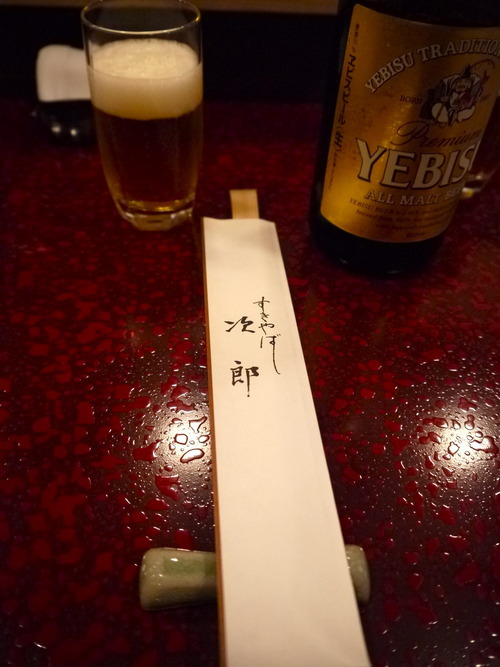

The Roppongi branch is the exact mirror image of the Ginza branch with the same sushi counter and dimensions. I counted 18 seats (including 2 tables) in the entire restaurant. The Ginza branch only recently started serving non-Japanese this past spring. The Roppongi branch is much more relaxed.
The younger Jiro-san is tall and stoic, yet bursts into a friendly smile whenever we fired questions at him.
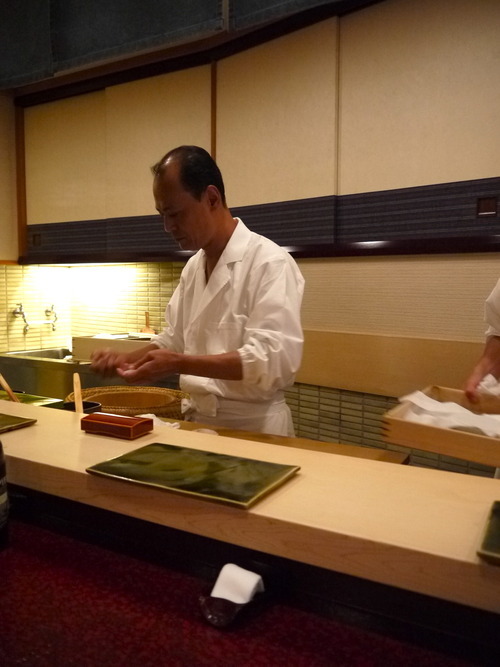
Our first sushi piece was hirame (fluke) a flat fish from the flounder family. The white flesh was firm, and left a very clean taste. I was surprised by how vinegary the sushi rice was compared to what I was accustomed to, but this was a welcome change and complimented the fish well.

Next came a pearly white piece of ika (cuttlefish). The slice was so glossy and sexy I almost didn’t want to destroy it by eating it. It was glazed with a sheen of soy sauce and the texture was firm yet tasted incredibly sweet and clean.
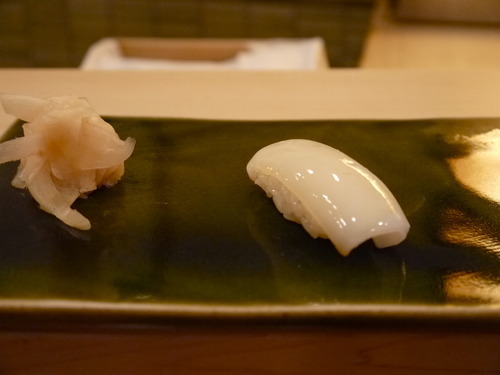
Jiro-san once said that the real sushi connoisseur preferred the taste of akami (lean red tuna) over chu-toro (medium fatty tuna) or o-toro (fatty tuna). Our piece of akami was glistening ruby red and pristine, with remarkable texture.

Perhaps I’m just not as sophisticated but I still love eating chu-toro (medium fat tuna) a lot more! I love the melt-in-your-mouth texture of the marbled fish, although o-toro (full fat tuna) is too greasy for my taste. Pictured below, my decadent piece of chu-toro.
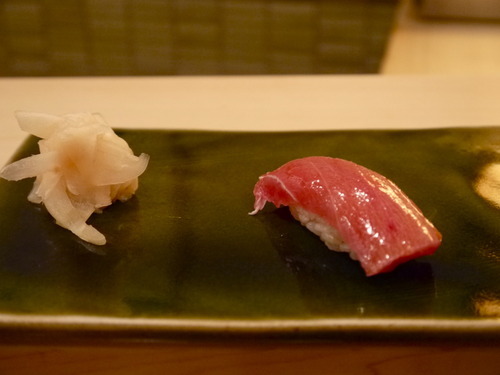
Next came a vinegary piece of silver kahada (sardine). The skin of the fish was beautifully patterned. Sardine usually tastes quite strong and fishy, but this piece was extremely fresh and clean with no fishy aftertaste.

As I mentioned in my previous posts, I am not a fan of abalone, but the Japanese really know how to make them! I thoroughly enjoyed this piece of simmered abalone, it was tender yet still retained some of its bouncy texture and full of sweet umami flavour. Jiro-san told us that abalone cannot be served raw because the texture would be too chewy, so it must be slowly simmered.

I am also not a fan of mackerel, but this piece is aji (horse mackerel) was incredible, accompanied by a tiny smudge of grated ginger.
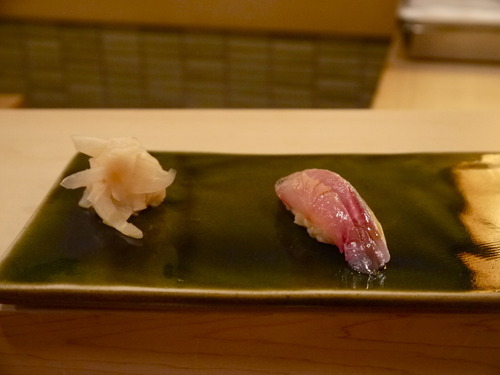
I love the practiced hand movements of Jiro-san, watching him hand press sushi was like watching a choreographed artist.
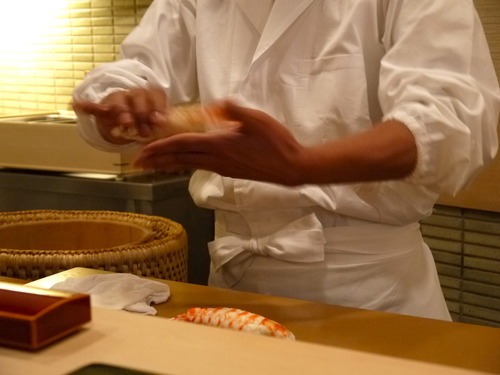
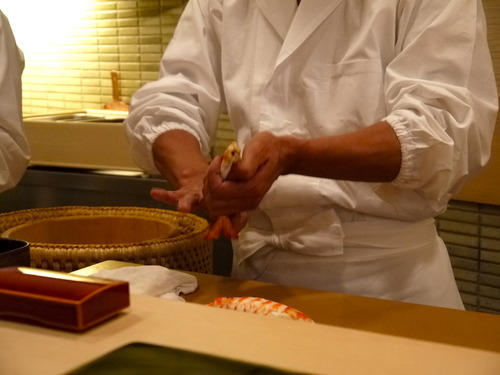
Ok, I confess – there is suppose to be 2 pieces of kuruma ebi (prawn) on my plate but I ate one before remembering to take a photo. The prawn was sweet and meaty, and Jiro-san served the prawns with their tails still attached for the boys, and for us girls, he took special care to cut the tails off so that we looked more “lady-like” while eating.
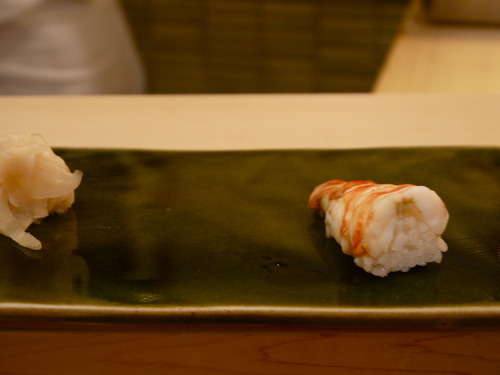
This was a stunning piece of fish – masaba mackerel, cut in such a way that you can see the thin layer of creamy opaque fat under the skin. The fish was incredibly fresh and very clean, and the texture of the fat just melts in the mouth.
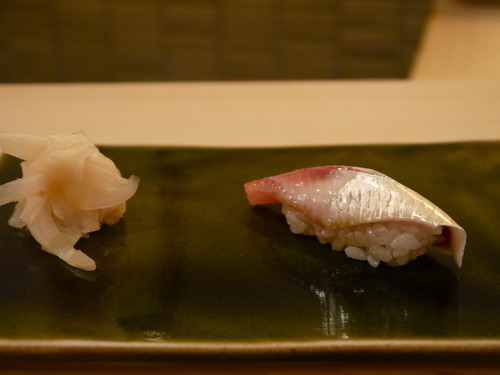
I love ikura (salmon roe) and this is one of the best I’ve tasted to date. The sign of excellence for ikura is that it should taste like gooey egg yolk mixed in rice with a touch of soy when you bit into it, and this piece conveyed this image brillantly.
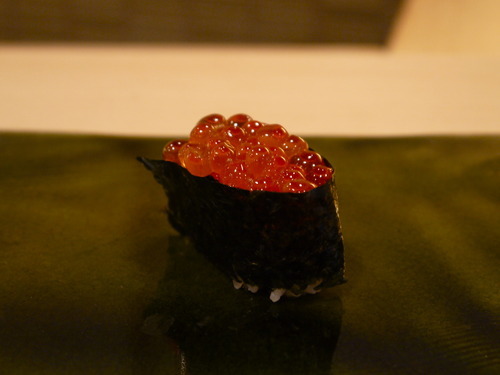
I was so excited about my sweet ikura experience that I forgot to write down the name of this next piece of fish, but I remember it being very firm and sweet with glistening silver skin.

Let’s talk about uni! Jiro-san brushed each uni piece with soy sauce. He cut the uni like a cake and stacked a huge mountain on top of each piece of rice. He told us that this may seem like a lot of uni, but it’s the perfect balance of proportions.

The uni here is in a class of it’s own, super fresh, super creamy, super sweet. I chewed and chewed, hoping to make the experience last longer.
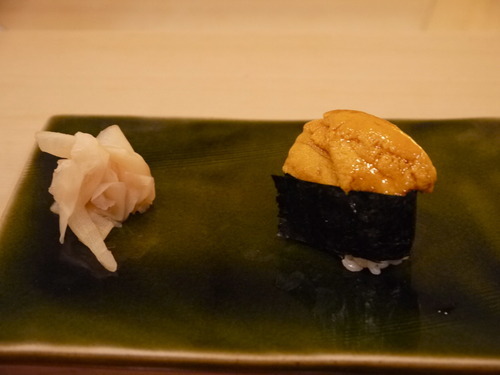
Jiro-san slicing into a thick slab of smoked bonito.
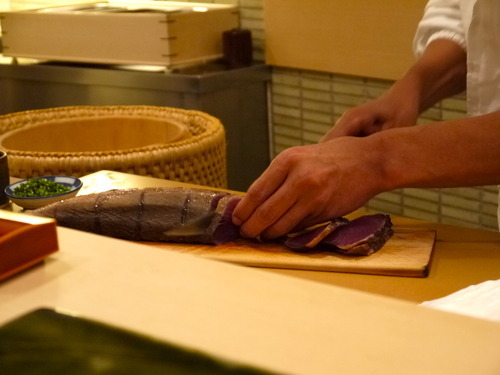
A beautiful slice of hearty smokey bonito.

Anago time!
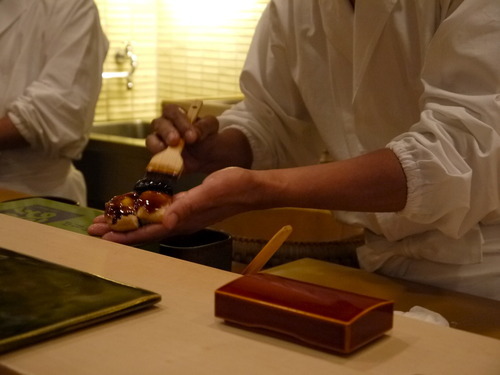
This is, by far, the best piece of anago (summer eel) I’ve tasted. It was epic. So sweet and tender, and melts in the mouth. The sweet sauce infused into the vinegary rice below – amazing combo.
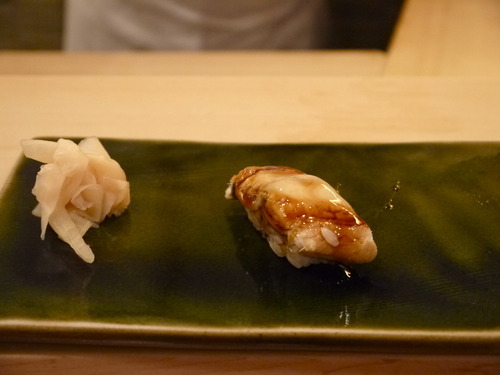
The badge of a good sushi chef is his tamago (sweet egg). In the documentary Jiro Dreams of Sushi, it took an apprentice 200 attempts before he was able to achieve an acceptable tamago. This tamago is unlike what you will find in a regular sushi restaurant, it’s so sweet and the texture is almost like a sponge cake. It truly is a dessert. Fresh minced shrimp is added to eggs to give it this incredible, cake-like texture.
Jiro-san took care to cut the tamago piece in half for the girls so we can savour it in lady-like fashion and not be overwhelmed with a huge mouthful.
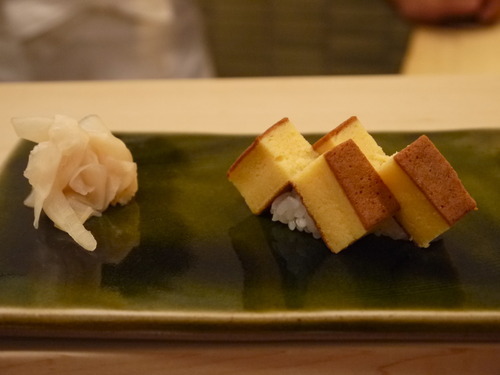
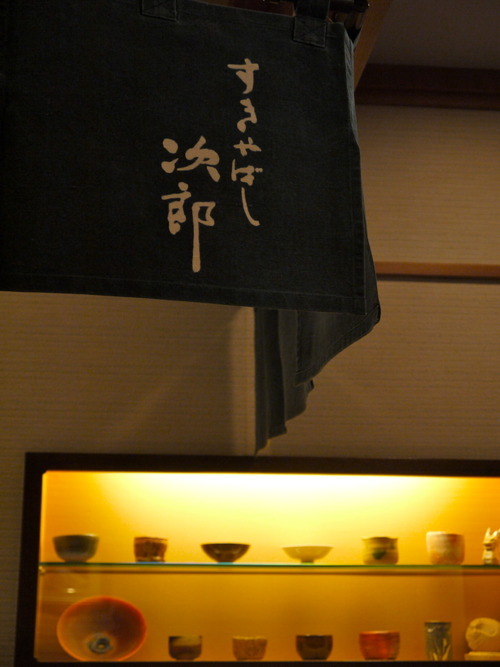
Jiro-san loved talking and entertained us with stories about his store, his family, and the seasonality of fish. He enthusiastically flipped through a book to show us the cross section of a tuna and how it differs from month-to-month. He told us that, although there are a lot more competition for fish now due to dwindling fish stock, the fish vendors at Tsuiji Market always saves the best for his restaurant because of their long friendships and because they know he can pay up. I asked our Japanese friend to ask whether there are ever fights between him and his father’s store on the best piece of fish, but our friend (who has more tact than I) politely declined to translate. Jiro-san came around the counter to take a group photo with us.

Verdict: This is a life-changing meal. After eating here, regular sushi restaurant will seem so…….passe. This is the best of the best for sushi, with the freshest ingredients. The chef truly dedicates his life to perfecting his craft. Prices are steep, but you are paying for quality. Our lunch was around US$250 per person, but well worth the experience.
Please note, DO NOT attempt to come without a reservation. During our lunch, a group of Americans came in and asked if they could expand their reservation from 2 to 4. Jiro politely obliged, although asked an apprentice to make the sushi instead. He also remarked that he did not have enough of his best ingredients to accommodate the extra 2 people. So if you want a true master at your sushi counter, make your reservation in advance!
With a last wave and sincere bow from Jiro-san, we said goodbye to Sukiyabashi Jiro, until next time!
Sukiyabashi Jiro Roppongi
Address: Roppongi Hills Residence, Tower B, 3/Floor, 6-12-2 Roppongi, Minato-ku
Tel: 03 5413 6626
2 Comments
Trackbacks/Pingbacks
- Sushi Shikon - […] Shikon serves edomae sushi. As our editor Celia explains, Edomae sushi is distinguished from your run-of-the-mill sushi mainly by …










Excellent review. Do you pay cash at Sukiyabaki Jiro, or Visa/AE are also possible?
Thanks for the kind comment – hope you have a delicious time at Jiro’s! Yes, they accept credit cards there, I think we used a Visa card to pay for our meal